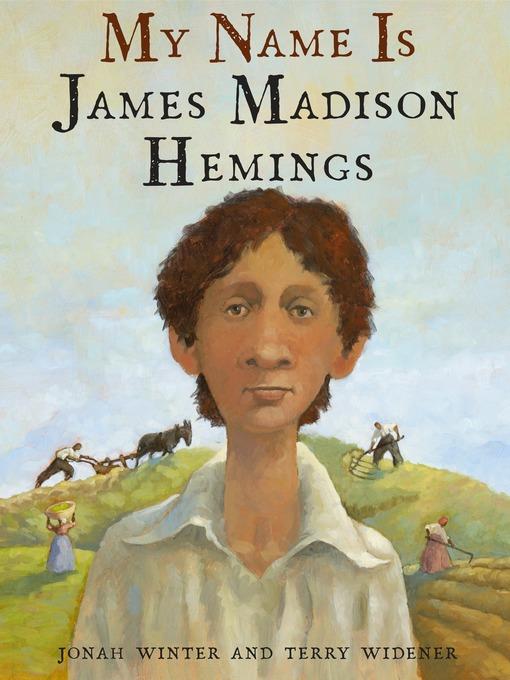
My Name Is James Madison Hemings
فرمت کتاب
ebook
تاریخ انتشار
2016
Lexile Score
910
Reading Level
3-5
ATOS
4.9
Interest Level
K-3(LG)
نویسنده
Terry Widenerشابک
9780385383448
کتاب های مرتبط
- اطلاعات
- نقد و بررسی
- دیدگاه کاربران
نقد و بررسی

August 15, 2016
The creators of You Never Heard of Willie Mays?! bring poignant and personal dimension to the story of Thomas Jefferson’s family with Sally Hemings through the fictionalized first-person perspective of one of their sons. A somber mix of historical details and plausible fictional particulars, the book was inspired by an 1873 newspaper interview with James Madison Hemings (1805–1877), in which he described his Monticello childhood and claimed his paternity. Alongside Hemings’s candid narration, Widener’s emotive acrylic art underscores his perception of his life’s station: he’s repeatedly pictured peering in from the outside, with Jefferson (who isn’t identified until late in the story) shown at a distance. With bewilderment, Hemings observes the difference between Jefferson’s loving relationship with his white grandchildren and the man’s indifference to Hemings and his siblings who, though spared from field work and given violins, were taught carpentry rather than Latin (“This was our education”). A moving final scene reveals Hemings as a free man and accomplished carpenter who is still perplexed about how his father—and master—viewed him: “Perhaps he would be proud. I do not know.” Ages 5–9. Author’s agent: Ginger Knowlton, Curtis Brown.

The life of James Madison Hemings, believed by most scholars to be one of several children Thomas Jefferson had with enslaved Sally Hemings, is imagined in this picture book of historical fiction.James Madison Hemings looks back at his childhood as an enslaved person at Monticello. As he grows up he learns Jefferson is his father, but this connection is never to be acknowledged. Madison, as he is referred to in historical accounts, relates how the unspoken relationship affects his and his siblings' lives: where they live, what they learn, and ultimately their freedom. "And yet, my name was written in my father's 'Farm Book'--the ledger where he recorded all his property." In this first-person narrative, a child's confused attempts to make sense of his situation ring true. Winter creates a tone of secrecy and distance in a place where no one is allowed to speak truth. Widener's acrylic illustrations with their pastoral palette contribute to this with stillness, though they are not static. The many images of Madison as an observer of his surroundings reflect the fact he was the only one of Sally Hemings' children to leave a written record of his life, a major source for Winter's story. The detailed author's note will be a welcome resource for adults, guiding them in answering young readers' questions. The strength of this telling is the way it encourages readers to empathize with Madison's plight, making it a solid entry in that class of picture books tackling tough topics. (Picture book. 5-9) COPYRIGHT(1) Kirkus Reviews, ALL RIGHTS RESERVED.

August 1, 2016
Grades 2-4 The author of many acclaimed nonfiction books, Winter takes on a neglected part of American history with the story of the son of Sally Hemings and Thomas Jefferson. A chestnut-haired boy, who stares at the reader from the cover, tells his tale in a straightforward yet moving first-person narrative that begins with a terse explanation of slavery. He and his siblings are the children of the man who owns his family. Though Jefferson remains unnamed for most of the book, he is portrayed as a writer, a violinist, a scholar. Sally Hemings is a worker, mending clothes and sweeping floors. For James, life is a series of juxtapositions. He lives and works in the house while he watches others toiling in the field. Jefferson's granddaughter teaches him to read, but his real education will be learning woodworking. He is a slave, but his father has promised that one day he will be set free. The question James asks near the book's beginning about his father haunts the rest of the story: How could I be both his slave and his son? Terry Widener provides compelling artwork throughout, from a picture of children listening to their mother as she tries to explain their parentage to an ironically pastoral scene of heavenly colored skies and green fields; one has to look closely to see the slaves planting crops. Like Heather Henson's similar Lift Your Light a Little Higher (2016), Winter's book raises the question of how far boundaries can be stretched when writing nonfiction. Winter tells us in his lengthy and informative author's note that his book is inspired by and partially based on an 1873 interview with Hemings. Aside from that, Winter continues, There is limited documentation. Though he says he has presented Hemings' story as historical fiction ( fictionalized biography might be a better term), the Library of Congress has given the book a Dewey number of 973.4, placing it on history shelves. Winter's book is built around the skeleton of a true story and the lives of real people, but incidents, motives, and thoughts are added. For instance, Jefferson gives James a violin, but Winter notes there is no record of who gave James an instrument, how he learned to play, and whether he ever heard his father play. Fictionalized biography is a popular trend in picture-book nonfiction, but it's worth noting that the target audience will see books in this genre as the truth. They aren't discerning enough to understand that a book presented as a biography isn't quite thatand they probably don't read author's notes. My Name Is James Madison Hemings tells a story worth telling, and Winter tells it very well. Still, the question lingers: How much leeway does an author have in reshaping a subject's life to make it fit the narrative? And how do we explain to children that the lines between fiction and nonfiction are not always as clear as they think?(Reprinted with permission of Booklist, copyright 2016, American Library Association.)

























دیدگاه کاربران